Icq Mac Os X 10.5 Download
At a Glance
Expert's Rating
Pros
- Addresses numerous shortcomings from previous OS versions
- Piece of cake backup tools
- Major improvements in included applications
- Improved security and networking functions
Cons
- Some bugs in Spaces window behavior
- Illegible menu items with some Desktop backgrounds
- Stacks and Dock features seem poorly thought out
The fifth major update to Mac OS X, Leopard, contains such a mountain of features — more than than 300 by Apple's count — that it's difficult to boil this $129 operating system release down to a few piece of cake bullet points. Leopard is, at one time, a major alteration to the Mac interface, a sweeping update to numerous included productivity programs, a serious attempt to improve Mac OS security, and a vast drove of tweaks and fixes scattered throughout every nook and cranny of the operating system.
As with every Bone Ten update since version 10.i, there'south no unmarried feature in Leopard that will force Mac users to upgrade immediately. Instead, it'south the sheer deluge of new features that's likely to persuade nigh active Mac users to upgrade, especially since this is the longest gap between OS 10 upgrades — two and a half years — since the product was introduced. Sure, some items on Apple tree'due south listing of 300 features might seem inconsequential, but if even a handful of them hit you where you lot alive, that will be more than enough motivation for yous to upgrade.
A new expect
Apple trumpets the interface changes in Leopard equally "stunning" and "middle-opening," but in reality the changes are a mixed purse.
First, the good stuff: After years of experimenting with dissimilar looks for windows, sidebars, and other interface elements, Apple seems to have settled on a adequately consequent interface. The color scheme is largely monochromatic—shades of gray with slight gradients. Apple has improved the contrast betwixt the frontmost window and the rest of them by increasing the summit window'south driblet shadow and dramatically lightening the colour of inactive windows. The Leopard Finder'southward new sidebar, conspicuously modeled after the iTunes Source List, is meliorate organized and more usable than its Tiger counterpart.
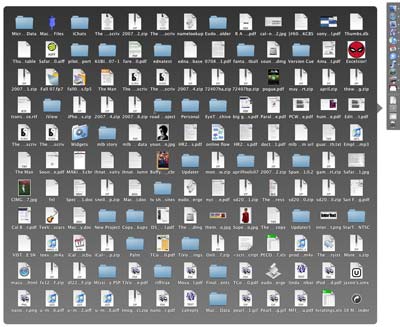 |
| When information technology comes to folders containing lots of documents, Stacks is non as useful. |
Unfortunately, some of the changes are not as successful. The Mac'southward trademark bill of fare bar, which spans the top of the screen, has been made semi-transparent. When the desktop is set to display an prototype with both light and nighttime areas, the run across-through card bar is visually hit. Unfortunately, that aesthetic option comes at also steep a price: the areas of low-cal and dark backside the carte du jour bar can severely decrease the readability of menu items.
Apple has modified the Dock, OS Ten's congenital-in program launcher, so that the Dock's icons appear to sit down on a cogitating glass tray when the Dock is positioned on the bottom of the screen. (Someone must've pointed out to Apple that the metaphor bankrupt down when the Dock is placed on the sides of the screen; in those orientations, the Dock's background is a simple half-transparent gray.) A pleasant glowing light appears next to the icons of currently-running programs, although the low-cal is a chip likewise subtle when the Dock is positioned at the lesser of the screen.
Unfortunately, the Dock's new Stacks feature is a mess, replacing a utilitarian approach to stashing folders in the Dock (click to open the folder, click and hold to encounter a list of the binder's contents) with a snazzy but more often than not less useful pop-up window featuring a stack or grid of icons. A potential feature touted during earlier demonstrations of Leopard — the ability to drag an arbitrary drove of items into the dock to make a temporary stack — apparently didn't get in to the concluding version.
Time Automobile
The nearly important new feature added in Leopard is undoubtedly Time Machine, Apple tree'due south attempt to encourage the vast majority of users who never, always routinely back upwards their data to change their ways. Time Machine automatically backs up a Mac's files to a carve up difficult drive (internal or external, though external is certainly safer and more user-friendly) or a network volume being shared by some other Mac running Leopard. Attaching a drive and assigning it every bit a Time Automobile fill-in volume is incredibly easy, and once you lot've set it up, you tin can essentially forget all almost information technology.
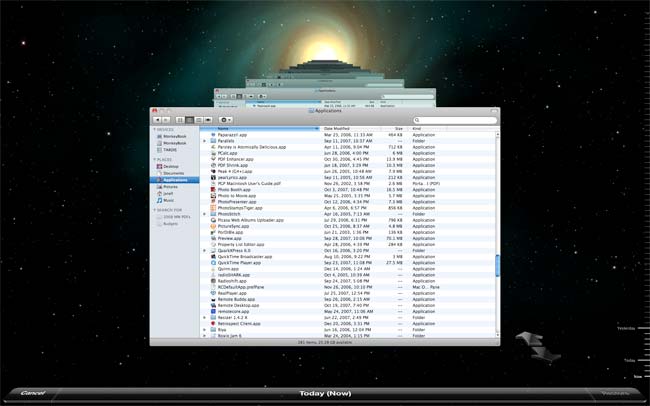 |
| Time Machine's interface looks a bit spaced out, but it makes incremental backups understandable. |
Perhaps the most impressive feature of Fourth dimension Machine is its support for incremental backups. Rather than creating an identical copy of your drive, it tracks the files you've inverse and saves those changes on an hourly footing. And grabbing an former re-create of a file isn't some complicated job designed for an Information technology professional person; with one click on the Time Automobile icon y'all're in the gratuitously spacey Time Machine interface, which lets y'all use the Finder (also every bit other supported applications such as iPhoto) to fly back in fourth dimension and pluck out the information you desire to recollect. Information technology really is backup for regular people, and the presence of Time Machine leads to a remarkable change in mindset: I only installed a new version of a plan I'g beta testing, and realized that if information technology didn't work, I could quickly roll dorsum to the previous version via Fourth dimension Machine.
One downside of Time Machine'southward backups is that they're not bootable on their own. If your main hard bulldoze dies, you need to supplant the drive and then rebuild your drive by using the Leopard kicking DVD's Restore role or the Migration Assistant utility. But all your files volition be there when you're done.
Volition Time Machine turn u.s. all into compulsive redundancy fanatics? No, because making that backup requires actual storage infinite, which requires the buy of a big backup bulldoze. But until online storage is infinitely vast and fast, that volition ever exist an outcome. The expert news is, Time Machine is simple enough that it really eliminates nearly of the obstacles that cause most people to bypass backing upwards their data. If y'all can buy a big hard drive and plug it into your Mac, yous can keep your data safe.
Kicking Camp
It'southward been xviii months since Boot Camp, Apple's method of allowing Intel-based Macs to boot into Windows, was released every bit a public beta. Boot Camp serves a useful purpose in that it provides basic Windows compatibility and the ability to run Windows programs at native speeds. However, nearly people who desire to run Windows software on their Macs volition opt for tools such as VMware Fusion and Parallels Desktop, which allow Windows and Mac Os X to operate simultaneously.
Still, the importance of Boot Camp can't exist understated. Its mere presence provides a bones level of Windows compatibility that many potential Windows-to-Mac switchers will detect comforting.
Spaces
Multiple-workspace utilities, which allow you switch between various collections of application windows in order to reduce clutter, have been around for years on numerous platforms, including Mac OS X. Leopard's new Spaces characteristic is an attempt to bring the concept of multiple workspaces to a much wider audition. While it's certainly promising, in the initial release of Leopard I found it to be a bit erratic.
Spaces has been integrated smartly into OS X's existing Exposé feature, another tool for organizing a large number of windows. The concept of Spaces is that the Mac's interface is actually a series of workspaces, located adjacent to i another on a grid. To drag a window out of a chaotic workspace and into a pristine one, you merely drag the window to the edge of the screen and, later on a momentary pause, the existing space will disappear and the window will appear by itself. Pressing the F8 key invokes an Exposé-style zooming feature, that reveals the contents of all the spaces and their spatial relationship to one another.
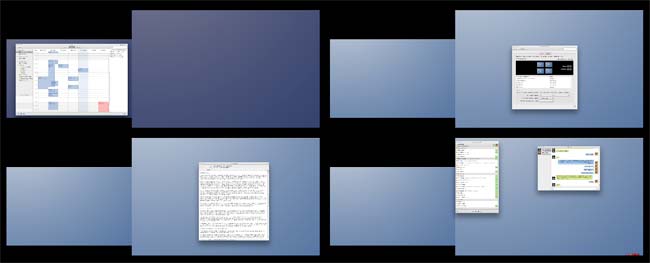 |
| A iv-workspace, ii-brandish fix of Spaces. |
I'm not convinced that multiple workspaces are e'er going to be a mainstream feature, but they tin can exist a huge productivity boost to busy power users. And Apple'due south implementation is quite nice, allowing you to assign private applications to specific spaces or to every space (a feature I used to make certain that my DragThing dock and iChat windows followed me wherever I went).
Yet, Spaces does accept some quirks. I institute that sometimes windows would announced in spaces that I didn't await, for reasons that I couldn't fathom. Some of my third-political party applications became quite dislocated until I set them to announced in every space. Sometimes I would launch a programme in one space and move to some other space, just to find that program's windows actualization in my new space.
However, Apple tree should be credited for bringing such a geeky characteristic to a broader group of users. While Spaces might never become a feature that takes the globe by storm, information technology does take the potential to dramatically improve the productivity of many users who would never take downloaded a third-party workspace utility.
Quick Look
Quick Look, which appears throughout Leopard, is a technology that lets users preview the contents of documents without opening the program that was used to create them. Click on a Microsoft Word file in the Finder and press space, and the entire file will announced before you, ready to be read (but not edited). Select a motion-picture show and press space, and the movie will expand and begin to play.
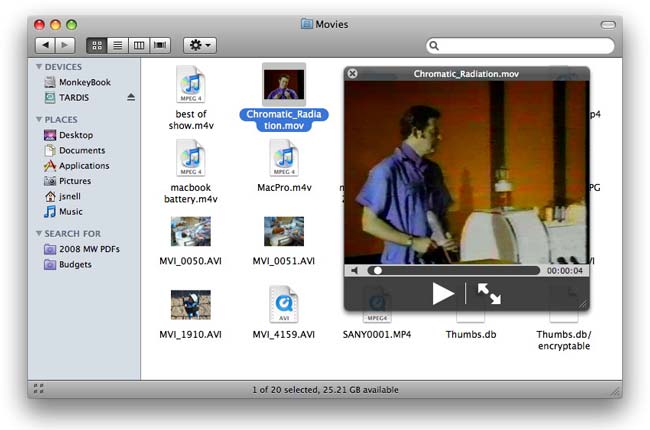 |
| Quick Look can play dorsum QuickTime movies without launching QuickTime Player. |
That aforementioned Quick Look applied science lets you optionally set up Finder views to display alive previews of documents. Spotlight and the Open and Save dialog boxes are also Quick Await savvy. And the Finder's new Embrace Flow view actually wouldn't be possible without this technology, which transforms dull document icons into live previews of each certificate's contents.
In practice, turning your Finder icons into live document previews isn't always very useful — text documents end up looking similar a wash of greyness. Only Quick Look itself is an impressive technology, if longtime users can retrain themselves to press infinite rather than double-clicking on a document to see what's inside.
Righting wrongs and improving features
In addition to the new features introduced in Leopard, this operating organisation release includes major updates to numerous existing programs that are included with Mac Os X.
The marquee feature of Leopard's predecessor, Tiger, was Spotlight, a desktop search engine that indexed the contents of all your Mac's documents and made them instantly accessible. It made for a swell demo, but in everyday use Spotlight was a existent letdown. Information technology was irksome, couldn't handle sophisticated queries, and failed to support the simplest query of all (namely, searches for a file with a specific name). With Leopard, Apple tree seems to have addressed most of Spotlight's failings. It'due south shockingly faster than it was in Tiger, and Spotlight now supports Boolean operators (and, or, and not). There's as well meliorate back up for saved searches and for searching files on networked Macs.
Mac OS X's built-in calendar programme, iCal, is at present v years former, merely Leopard's iCal 3.0 is the first version that doesn't feel like a toy. The iCal interface is more straightforward and responsive, and the ability to edit entries by double-clicking on them eliminates the unwieldy Go Info pane of previous versions. iCal three.0 too supports the CalDAV standard for group calendaring, which threatens to turn iCal into a true business tool. Unfortunately, nosotros weren't able to test these features on a CalDAV server (one ships with the server version of Leopard, and since the server is based on an open-source server framework, the streets will likely be littered with CalDAV server implementations earlier as well long).
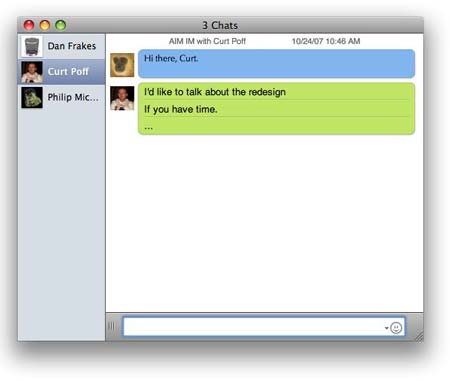 |
| iChat's new tabbed interface, with a chat displayed in the new Compact display option. |
Apple's iChat IM customer has also received an excellent update, addressing nigh all of the plan's flaws. Audio chat audio quality, which previously lagged sadly behind Skype's, is noticeably better. Information technology's much easier to manage multiple chats via a tabbed chat interface (previously only available in iChat via an improver such every bit Chax ). And perhaps most chiefly, iChat now allows you to log into multiple AIM accounts at one time. All that's missing now is support for competing conversation services such equally those offered by Yahoo and MSN.
Apple Mail 3.0 has as well seen numerous improvements, although perchance the biggest one is the improved speed of Spotlight, which makes searching for messages within Mail much less painful. Mail as well now has back up for to-do lists and "notes," in which y'all exit letters to yourself. Mail seems to be an odd identify to stow this data, and the to-do interface in Mail service is poorer than the 1 in iCal. Although Mail'south notes look a lot like the notes on the iPhone, the 2 don't sync. Another out-of-place Post feature addition is support for RSS feeds, which are already supported in Safari and numerous third-party feed-reading programs. But Mail'due south interface is actually quite conducive to RSS reading, and I establish reading RSS feeds in Mail to be enjoyable. It'll never be appropriate for heavy RSS consumers, merely for casual RSS users information technology really hits the spot.
Os X's included Preview utility is probably the about unheralded productivity plan in OS X. (By default, it's the tool that opens images and PDF documents when yous double-click on them in the Finder.) But it may exist harder for Preview to remain a secret at present that it's been given a major facelift with Leopard. Preview 4.0 gives Acrobat a run for its money when it comes to basic PDF features, improving back up for PDF annotations, improving searches within PDF documents, and providing built-in tools to reorder pages and combine PDFs into a single document. Preview'due south paradigm manipulation tools have also improved, including the addition of the "Instant Blastoff" background-removal tool that Apple tree first introduced in iWork '08.
Numerous other included tools have received major improvements in Leopard, every bit well. Safari three, which has been available in beta course since June, offers a dramatically improved Find command and resizable text fields for Web forms. It also includes Web Clip, a tool that allows yous to "clip" part of a Web page and turn it into a Dashboard widget. (Despite the improver of this feature and a new picture show widget, Dashboard even so doesn't seem to exist remotely the paradigm shift that Apple tree suggested it would be when it was introduced with Tiger. I often find myself forgetting that information technology's even there.)
The Dictionary utility has added support for Wikipedia as an additional data source, and it's nicely integrated into the awarding'southward interface. For everyone who hasn't abandoned DVDs for the wonders of the iPod, DVD Player has been completely overhauled, giving users much better command over navigating DVD content, including a TiVo-like spring-back characteristic. And Front Row, which replaces the Mac interface with a remote-control driven card arrangement for navigating iTunes content, has been updated to use essentially the same software as the Apple tree TV hardware device, meaning any Mac with an infrared sensor and Leopard tin can play dorsum music and videos using the slick Apple TV interface.
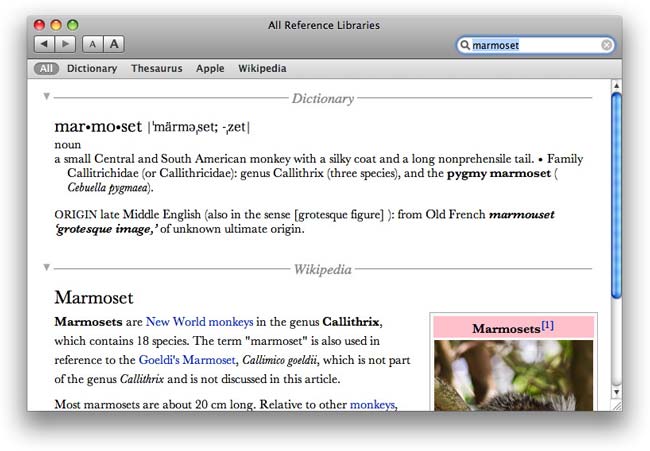 |
| Wikipedia adds a depth of information to the built-in Lexicon utility. |
The introduction of the Automator utility in Tiger suggested the hope of regular users taking advantage of automation technologies previously express to people who knew their manner around scripting languages such as AppleScript. As it turned out, Automator was pretty cool — but in one case you wanted to automate more complicated tasks, you lot'd encounter its limitations pretty quickly. In Leopard, Automator has been updated to address its two greatest limitations: y'all can now prepare and read variables during a workflow, and you can gear up a workflow to loop. Automator also at present has a Record feature, which lets you tape yourself performing certain tasks and then integrates those tasks into an Automator workflow.
Finally, Leopard shows remarkable improvement when it comes to treatment networking issues. It'south much easier to dismount remote servers, and attempting to access a server that's disappeared no longer causes an interminable look. (That's an consequence that should have been resolved by Apple tree long ago, simply at least with Leopard it'due south finally been addressed.) The Networking preference pane has likewise been updated with a better-organized interface.
Improved security
Mac Bone X and its users haven't notwithstanding felt the sting of a major hacker assail, just in the two years since the release of Tiger, Apple and other engineering science companies take come nether increased scrutiny about the relative security of their products. And Leopard includes a big number of new features that specifically address security concerns.
Most regular users won't find the fact that several Leopard applications are "sandboxed" with restricted admission privileges that make them less likely to exist used as tools in a hacker attack. Nor volition they realize that Leopard now uses a shifting arrangement of assigning memory spaces in social club to get in impossible for hackers to bank on the presence of specific lawmaking in a specific area of a Mac's retentiveness. What they will discover is that when they start attempt to run a program they've downloaded from the Internet, they'll be prompted with information near when they downloaded it and what program was used to download information technology. Apple has done a skilful chore of making its security messages more understandable to regular users, which is skillful, since most users will simply click through a dialog box that makes no sense.
And hundreds more than
Information technology's impossible to detail the avalanche of new features in Leopard. Screen Savers and international spelling dictionaries aside, Apple's list of "300+ new features" isn't far off. If you use Photo Booth, Parental Controls, Image Capture, VPN, Terminal, or but about any other feature you lot tin can recollect of in Mac OS Ten, you'll find at least some changes.
Macworld'due south ownership advice
So are 300-plus new features worth $129? That reply will vary, considering no single user will e'er take advantage of all — or perchance even half — of those 300 features. But given the impressive value of Time Machine and improvements to existing programs such as iCal, iChat, Mail, and the Finder, most agile Mac users volition find more than enough reasons to consider that upgrade cost money well spent. Despite a few interface missteps, particularly when it comes the menu bar and the Dock, Leopard is an upgrade that roars.
[ Jason Snell is Macworld's editorial manager. ]
Note: When you purchase something after clicking links in our articles, we may earn a small commission. Read our affiliate link policy for more than details.
Icq Mac Os X 10.5 Download
Posted by: hankinsthaversonly.blogspot.com

0 Comments